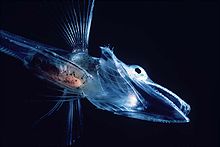- Notothenioidei
-
Antarctic icefish 
An icefish off the coast of Antarctica. Scientific classification Kingdom: Animalia Phylum: Chordata Class: Actinopterygii Order: Perciformes Suborder: Notothenioidei Families Bovichtidae
Pseudaphritidae
Eleginopidae
Nototheniidae
Harpagiferidae
Artedidraconidae
Bathydraconidae
Channichthyidae
See text for genera.The Antarctic icefish belong to the perciform suborder Notothenioidei and are the largely endemic, dominant fish taxa in the cold continental shelf waters surrounding Antarctica. At present, the suborder includes 8 families with 43 genera and 122 species. Although the Southern Ocean is relatively well sampled, new species of notothenioids are still being described.
The majority of Notothenioids live at seawater temperatures between of –2°C and 4°C, but some sub-polar species inhabit waters that may be as warm as 10°C around New Zealand and South America. It is possible to have seawater temperatures below the freezing point of fresh water (0°C) because dissolved salts lower the freezing point of a solution in a colligative manner. Notothenioids have a depth range of about 1500 metres.
The notothenioids all lack a swimbladder, and the majority of species are therefore benthic or demersal in nature. However, a depth-related diversification has given rise to some species attaining increased buoyancy, using lipid deposits in tissues and reduced ossification of bony structures. Reduced ossification of the skeleton in the Notothenioids changes their weight and henceforth has created a sort of neutral balance in the water, where the notothenioid does not sink nor float, and can thus adjust depth easier.
Notothenioids have evolved a variety of interesting physiological and biochemical adaptations that either permit survival in, or are possible only because of, the generally cold, stable seawater temperatures of the Southern Ocean. Many Notothenioid fish are able to survive in the freezing, ice-laden waters of the Southern Ocean because of the presence of an antifreeze glycoprotein in blood and body fluids. Although many of the Antarctic species have antifreeze proteins in their body fluids, not all of the Antarctic species do. Some sub-polar species either produce no or very little antifreeze, and antifreeze concentrations in some species are very low in young, larval fish.
While the majority of animal species have up to 45% of haemoglobin (or other oxygen-binding and oxygen-transporting pigments) in their blood, the Notothenioids of the family Channichthyidae have only 1%. They can still flourish in part because of the high oxygen content of the cold waters of the Southern Ocean and in part because oxygen is absorbed and distributed directly by the plasma. These fish must expend twice as much energy in cardiac output per second than the notothenioids with higher hemoglobin concentration.
The notothenioids are generally considered the only marine fish species flock.
Comparing the genomes of Notothenioidei, which lack red blood cells, to close relatives such as the Antarctic rockcod has revealed genes needed to make these blood cells.[1]
Classification
This classification follows Eastman and Eakin, 2000.[2]
- Family Bovichtidae
- Genus Bovichtus (9 species, 8 non-Antarctic)
- Genus Cottoperca (1 species, non-Antarctic)
- Family Pseudaphritidae
- Genus Pseudaphritis (1 species, non-Antarctic)
- Family Eleginopidae
- Genus Eleginops (1 species, non-Antarctic)
- Family Nototheniidae
- Genus Aethotaxis (1 species)
- Genus Cryothenia (2 species)
- Genus Dissostichus (2 species)
- Genus Gobionotothen (4 species)
- Genus Gvozdarus (1 species)
- Genus Lepidonotothen (6 species, 1 non-Antarctic)
- Genus Notothenia (5-7 species, 2-3 non-Antarctic)
- Genus Pagothenia (2 species)
- Genus Paranotothenia (2 species)
- Genus Patagonotothen (14 species, all non-Antantarctic)
- Genus Pleuragramma (1 species)
- Genus Trematomus (11 species)
- Family Harpagiferidae
- Genus Harpagifer (6 species)
- Family Artedidraconidae
- Genus Artedidraco (6 species)
- Genus Dollodidraco (1 species)
- Genus Histiodraco (1 species)
- Genus Pogonophryne (22 species)
- Family Bathydraconidae
- Genus Acanthodraco (1 species)
- Genus Akarotaxis (1 species)
- Genus Bathydraco (5 species)
- Genus Cygnodraco (1 species)
- Genus Gerlachea (1 species)
- Genus Gymnodraco (1 species)
- Genus Parachaenichthys (2 species)
- Genus Prionodraco (1 species)
- Genus Psilodraco (1 species)
- Genus Racovitzia (1 species)
- Genus Vomeridens (1 species)
- Family Channichthyidae
- Genus Chaenocephalus (1 species)
- Genus Chaenodraco (1 species)
- Genus Champsocephalus (2 species)
- Genus Channichthys (1 species)
- Genus Chionobathyscus (1 species)
- Genus Chionodraco (3 species)
- Genus Cryodraco (1 species)
- Genus Dacodraco (1 species)
- Genus Neopagetopsis (1 species)
- Genus Pagetopsis (2 species)
- Genus Pseudochaenichthys (1 species)
- Genus Brulenthius (1 species)
- Brulenthius communis
References
- ^ Yergeau DA, Cornell CN, Parker SK, Zhou Y, Detrich HW (2005). "bloodthirsty, an RBCC/TRIM gene required for erythropoiesis in zebrafish". Dev. Biol. 283 (1): 97–112. doi:10.1016/j.ydbio.2005.04.006. PMID 15890331.
- ^ J. T. Eastman & R. R. Eakin (2000). "An updated species list for notothenioid fish (Percifomes; Notothenioidei), with comments on Antarctic species". Arch. Fish. Mar. Res. 48 (1): 11–20. http://www.oucom.ohiou.edu/dbms-eastman/Articles/Noto.PDF.
Categories: - Family Bovichtidae
Wikimedia Foundation. 2010.
